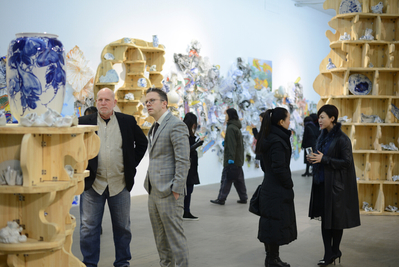Collaborating Across Culture: A Conversation with Mark Cooper

Installation view, Mark Cooper: YuYu China Blue, Yuan Art Museum, Beijing, China. Courtesy of Mark Cooper, Samsøñ, and the Yuan Art Museum
By Olivia J. Kiers
With the help of Boston’s Samsøñ Projects, artist Mark Cooper recently collaborated with artists in China to create a multimedia installation incorporating sculpture, ceramics, painting and video at the Yuan Museum in Beijing, titled YuYu China Blue (January 12–February 29). Cooper talks to ANE Portfolio about the exhibition.
ANE: How was YuYu China Blue born? When did you first begin working on it, and how was Samsøñ Projects involved?
Cooper: I went to China for the first time more than two years ago to make some ceramics for the exhibition New Blue and White at the Museum of Fine Arts, Boston. I did a lot of touring. The gardens in Shanghai were a big influence; its architectural portals and rock formations acted on a whole series of work.
I was invited by the head of the Yuan Museum to do an exhibition a year and a half ago. Camilo Alvarez [director at Samsøñ] was officially invited to be the curator. We had many conversations with the Yuan Museum months before going there to install.
ANE: What are the differences or similarities between working with a Chinese museum and a US museum, in your experience as a New England-based contemporary artist who has completed many projects for museums and other institutions?
Cooper: That is a broad question because different Chinese museums function in different ways. The Yuan Museum was the full-on supporter of this project. They invested in it and promoted it in all ways I’d say a US museum would do. However, many museums in China rent their spaces, and so museums and the art market in general is different in China than it is in the US and Europe. But, the Yuan Museum’s mission is ideas—adding to the contemporary conversation and adding to an international dialog.

Installation view, Mark Cooper: YuYu China Blue, Yuan Art Museum. Courtesy Mark Cooper, Samsøñ, and the Yuan Art Museum.
ANE: In your opinion, what does China bring to the contemporary art-making world? How are Chinese artists looking toward the future?
Cooper: In China, there is a very strong tradition of holding on to the traditional arts. What I brought was this other, idea-based notion of making imagery and creating these objects collaboratively, giving up ownership and embracing the conversation between the parts. Having said that, it is changing radically. Mary Ellen Strom, who is head of the graduate program at the Museum School (SMFA), and I met several times with faculty at the Central Academy of Fine Art in Beijing (CAFA), and the faculty we met were very international, very sophisticated, well-traveled, and conceptual in their approach to making their art… Collaborating entered our conversations and we were quite excited about it.
ANE: Would you say your history making collaborative art in the US informed YuYu China Blue in profound way?
Cooper: Absolutely, but it is not just about collaboration. I’m interested in visual language, visual history… That includes an approach that is collage-based—an assemblage. One of the things I’ve learned is that collage and installation trigger the viewer’s mind in a different way than a linear narrative might… The move into collaboration is very natural because it is just adding more visual language to this approach.
ANE: Returning to YuYu China Blue’s imagery, what is the message of the Shanghai Gardens and blue and white porcelain for the viewer?
Cooper: China influenced the world for centuries with blue and white porcelains, so I thought that was an interesting starting place… The gardens, for me, provided a really interesting combination. My sculptural wooden forms have a lot of reference to architecture, [but] they also reference organic things like a bee nest or what you see at the bottom of the ocean. Architecturally, they serve as curio cabinets gone crazy.
One of my discoveries in China is that you go places and see these whole installations in temples and in homes… where all the parts—paintings, ceramics—are talking to each other. It just resonated as a good place to start. It resonated as a common language, of something that is based in tradition, but moves into this international conversation. Where are we and how are we tied together?
————–
This is the second installment in ANE Portfolio’s series, “China and the Contemporary Arts in New England.” To read the previous story on the International Sculpture Parks Union conference, visit here.
